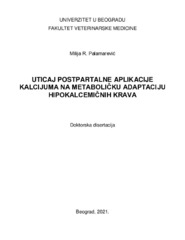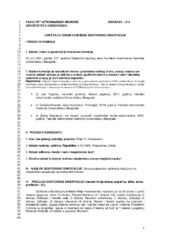Приказ основних података о дисертацији
Uticaj postpartalne aplikacije kalcijuma na metaboličku adaptaciju hipokalcemičnih krava
Effect of postpartum calcium application on metabolic adaptation of hypocalcemic cows
| dc.contributor.advisor | Vujanac, Ivan | |
| dc.contributor.other | Kirovski, Danijela | |
| dc.contributor.other | Sladojević, Željko | |
| dc.creator | Palamarević, Milija | |
| dc.date.accessioned | 2022-11-08T07:58:36Z | |
| dc.date.available | 2022-11-08T07:58:36Z | |
| dc.date.issued | 2022-01-17 | |
| dc.identifier.uri | https://eteze.bg.ac.rs/application/showtheses?thesesId=8789 | |
| dc.identifier.uri | https://fedorabg.bg.ac.rs/fedora/get/o:26918/bdef:Content/download | |
| dc.identifier.uri | https://plus.cobiss.net/cobiss/sr/sr/bib/78725129 | |
| dc.identifier.uri | https://nardus.mpn.gov.rs/handle/123456789/20798 | |
| dc.description.abstract | Hipokalcemija je jedan od najučestalijih metaboličkih postpartalnih poremećaja kod krava. Pored klinički vidljive forme, javlja se supklinički oblik koji je teško detektovati zbog izostanka kliničke slike. Pravovremeni tretman ovih jedinki je ključan za održivost proizvodnje i zdravlja krava posle teljenja. Podaci iz literature su neusaglašeni u pogledu ishoda terapije, zbog čega smo smatrali da je značajno ispitati mehanizme koji se nalaze u osnovi terapijskih procesa koji se primenjuju kod hipokalcemičnih krava. Cilj ovog rada je bio da se utvrdi prevalenca supkliničke hipokalcemije i ispita efekat peroralne i parenteralne aplikacije preparata Ca na aktivnost paratireoidne žlezde, metaboličke parametre u postpartalnih krvi krava sa supkliničkom hipokalcemijom. U ispitivanje je uključeno 180 krava od 3. do 7. laktacije, kojima je 5 do 15 sati posle teljenja određena kalcemija. U ogled su uvedene krave (n= 24) sa supkliničkom hipokalcemijom (1,38 mmol/l ≥Ca ≤ 2,0 mmol/l), podeljene u tri grupe: (1) IV-Ca (n=8) jednokratno tretirana intravenskom aplikacijom 500 ml Calci–kel 300 (12,5 g Ca glukonata, 2,4 g Mg hlorida i borna kiselina), (2) PO-Ca (n=8) dvokratno tretirana (1 l pri dijagnostikovanju oboljenja i 0,5 l 12 sati kasnije) oralnom suspenzijom Calci Tonica (helatno vezani joni Ca i Mg, odnosno 41g Ca i 5g Mg po litru), (3) KON (n=8) nije tretirana preparatima Ca i Mg. Krv je uzorkovana 0. časa (momenat dijagnostikovanja supkliničke hipokalcemije, neposredno pre tretmana) kao i 1., 2., 4., 8., 12., 20., 24., 36. i 48. sata. Uzorci urina su uzimani 0., 1., 12., 24., 36. i 48. sata. Kalcemija je određivana u svim uzorcima krvi. Koncentracija parathormona (PTH) u krvi je merena 0., 1., 2., 4., 24 . i 48. sata. Koncentracija glukoze, ukupnih proteina, albumina, uree, kreatinina, ukupnog bilirubina, BHBA, anorganskog fosfora, magnezijuma i aktivnost enzima gGT, AST i ALP određivana je u uzorcima krvi uzetim 0., 24., i 48. sata, a koncentracija NEFA samo 0. sata. pH urina je određen u svim uzorcima urina. Ukupna prevalenca supkliničke hipokalcemije je bila 13%, pri čemu je bila najveća u četvrtoj (42%) i petoj (37%), a najniža u trećoj laktaciji (3,03%). Pre tretmana nije bilo značajne razlike u kalcemiji između grupa, dok je u odnosu na KON grupu kalcemija bila značajno veća nakon tretmana kod PO-Ca (do 8. časa) i IV-Ca (do 24. časa). Kod PO-Ca grupe fiziološka kalcemija uspostavljena je tokom prva 2 sata nakon tretmana i održavala se do kraja ogleda, dok je kod IV-Ca grupe prva dva sata nakon tretmana došlo do hiperkalcemije, a zatim je uspostavljena normokalcemija do kraja ogleda. Kalcemija KON grupe bila je ispod donje fiziološke granice do 48. sata od početka ogleda. Pre tretmana nije bilo značajne razlike u koncentraciji PTH, dok su nakom tretmana vrednosti bile značajno niže u odnosu na KON grupu kod IV-Ca prvog i drugog sata a kod obe tretirane grupe (PO-Ca, IV-Ca) četvrtog sata i zatim kod PO-Ca sve do kraja ogleda. Na osnovu izmerenih početnih vrednosti pH urina, kod svih krava je ustanovljena metabolička alkaloza. Nakon jednog sata kod IV-Ca grupe ustanovljena je acidoza, pri čemu je pH urina kod ove i PO-Ca grupe bio značajno niži nego kod KON grupe. Dvanaest sati nakon tretmana, pH urina PO-Ca i IV-Ca grupe bio je značajno niži nego kod KON grupe. Kod PO-Ca grupe pH urina je bila značajno niža nego kod KON grupe 24. i 36. sata, dok 48. sata između pH urina ispitivanih grupa nije bilo razlike. Koncentracije glukoze, BHBA, NEFA i kreatinina, kao i aktivnosti enzima GGT i ALP nisu se značajno razlikovale između ispitivanih grupa krava tokom ogleda. Na početku ogleda kod svih krava je ustanovljena hipofosfatemija. Nakon 48 sati, kod IV-Ca grupe vrednost aP je bila značajno niža nego kod KON grupe, dok se kod PO-Ca grupe nije razlikovala od vrednosti kod KON grupe... | sr |
| dc.description.abstract | to the clinically visible form, there is a subclinical form that is difficult to detect due to the absence of a clinical signs. Timely treatment of cows is crucial for the sustainability of production and health of cows after calving. Data from the literature are inconsistent regarding the outcome of therapy, which is why we considered important to examine the mechanisms underlying the therapeutic processes applied in hypocalcemic cows. The aim of this study was to determine the prevalence of subclinical hypocalcemia and to examine the effect of oral and parenteral administration of Ca preparation on the activity of the parathyroid gland, metabolic parameters in blood of postpartum cows with subclinical hypocalcemia. The study included 180 cows from the 3rd to the 7th lactation, from which blood was taken 5 to 15 hours after calving in order to determine the level of blood calcium. Cows (n = 24) with subclinical hypocalcemia (1.38 mmol/l ≥Ca ≤ 2.0 mmol/l) were divided into three groups: (1) IV-Ca (n = 8) treated once by intravenous administration of 500 ml Calci-kel 300 (12.5 g Ca gluconate, 2.4 g Mg chloride and boric acid), (2) PO-Ca (n = 8) treated twice (1l when diagnosing the disease and 0.5 l 12 hours later) oral suspension of Calci Tonic (chelation bounded Ca and Mg ions, respectively 41g Ca and 5g Mg per liter), (3) KON (n = 8) was not treated with Ca and Mg. Blood was sampled at hour 0 (moment of diagnosis of subclinical hypocalcemia, immediately before treatment) as well as at 1, 2, 4, 8, 12, 20, 24, 36 and 48 hours. Urine samples were taken at 0, 1, 12, 24, 36, and 48 hours. Calcemia was determined in all blood samples. The concentration of parathyroid hormone (PTH) in the blood was measured at 0., 1., 2., 4., 24. and 48 hours. Concentrations of glucose, total proteins, albumin, urea, creatinine, total bilirubin, BHBA, inorganic phosphorus, magnesium and enzyme activity of gGT, AST and ALP were determined in blood samples taken at 0, 24, and 48 hours, and the concentration of NEFA only at hour 0. Urine pH was determined in all urine samples. The overall prevalence of subclinical hypocalcemia was 13%, with the highest in the fourth (42%) and fifth (37%) and lowest in the third lactation (3.03%). Before treatment, there was no significant difference in calcemia between the groups, while in relation to the KON group, calcemia was significantly higher after treatment in PO-Ca (up to 8 hours) and IV-Ca (up to 24 hours). In the PO-Ca group, physiological calcemia was established during the first 2 hours after treatment and was maintained until the end of the study, while in the IV-Ca group, hypercalcemia occurred in the first two hours after treatment, and then normocalcemia was established until the end of the study. Calcemia of the KON group was below the lower physiological limit until the hour 48th from the beginning of the experiment. Before treatment, there was no significant difference in PTH concentrations between groups, while after treatment the values were significantly lower compared to the KON group in IV - Ca during first two hours, and in both treated groups (PO-Ca, IV-Ca) in the fourth hour and then significantly lower PTH was established in PO-Ca, compared to KON, until the end of the study. Based on the measured initial values of urine pH, metabolic alkalosis was established in all cows. After one hour, acidosis was found in group IV-Ca, with the urine pH in this and PO-Ca groups being significantly lower than in the KON group. Twelve hours after treatment, urine pH of PO-Ca and IV-Ca groups were significantly lower than in KON group. In the PO-Ca group, the pH of urine was significantly lower than in the KON group at 24 and 36 hours, while at hour 48 there was no difference between the pH of urine of the examined groups. Concentrations of glucose, BHBA, NEFA and creatinine, as well as GGT and ALP enzyme activities did not differ significantly between the examined groups of cows during the study... | en |
| dc.format | application/pdf | |
| dc.language | sr | |
| dc.publisher | Универзитет у Београду, Факултет ветеринарске медицине | sr |
| dc.rights | openAccess | en |
| dc.rights.uri | https://creativecommons.org/licenses/by-nc-nd/4.0/ | |
| dc.source | Универзитет у Београду | sr |
| dc.subject | krave, hipokalcemija, parathormon, terapija | sr |
| dc.subject | hypocalcemia, parathyroid hormone, therapy | en |
| dc.title | Uticaj postpartalne aplikacije kalcijuma na metaboličku adaptaciju hipokalcemičnih krava | sr |
| dc.title.alternative | Effect of postpartum calcium application on metabolic adaptation of hypocalcemic cows | en |
| dc.type | doctoralThesis | |
| dc.rights.license | BY-NC-ND | |
| dc.identifier.fulltext | http://nardus.mpn.gov.rs/bitstream/id/146809/Disertacija_12716.pdf | |
| dc.identifier.fulltext | http://nardus.mpn.gov.rs/bitstream/id/152530/Referat.pdf | |
| dc.identifier.rcub | https://hdl.handle.net/21.15107/rcub_nardus_20798 |



